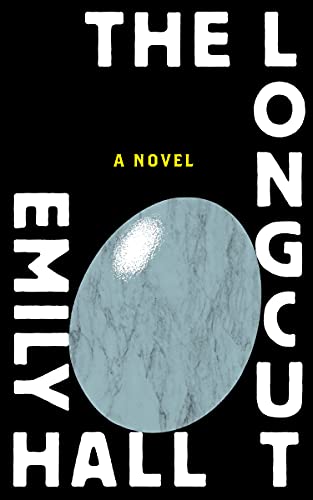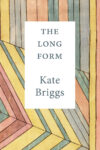
[Dalkey; 2022]
Why trouble the reader’s judgment with force of voice? On a panel in October 1975, William Gass told Donald Barthelme, “I don’t want the reader filling in anything behind the language”:
Ideally the suggested meaning has to be in an exactly particular order because at that point the suggested other sentence isn’t written down directly. You can’t just throw in a number of words any old way . . . the implications have to be as completely written out, yes, you’ve got to get the implications.
Done well, fiction guided unequivocally by the sound and privacy of an idiosyncratic voice—The Tunnel, for example—makes for a more visceral experience of reading. “Fearful yet hopeful as a laboratory mouse,” in Gass’s words, the reader is often made to follow blind. Gass worries that more creative readers, suspicious of their instincts, of him as their guide, of his novel altogether, may lose in their timidity the chance to find greater clarity of mind, conscience, and even self through total submission to what Gass calls the fascism of the heart.
But the novelist who knows the success of her story depends on the weight of her voice will deputize and flatten plot and character accordingly. She’ll never bait the creative reader; she appreciates the risk of marooning herself between poles of intention, writing one page that mimics convention while desperately experimenting on another.
We may seldom get from Gass and Barthelme such ordinary comforts as date and time, but we get the implications. With alacrity, in her recent debut, The Longcut, Emily Hall follows them nowhere.
Nameless, office do-nothing by day, obscure artist by night, soaked with doubt, intellectually transgressive, Hall’s narrator is plasticity personified. She believes art is a tragic exercise in the interpretation of the incomprehensible; that categories do not define but constrict; that deconstruction reveals truth. Yet something, “I,” endures:
I saw that the way past death was to do anything I could to unfind the answer to the question of what my work was, to unaccept the fact of knowing the answer, to unknow, uncomplete, unaccept, unclose. I would unsolve for x, I would deny there was an x to be solved. I would arrange things to my dissatisfaction in all cases, every case would be the case, I would botch every transition, every border crossing, botching every border between categories or realms, dwelling in the botched transition, the hiccup, the glitch. I would plunge within limits and botch the limits, I would botch the pale, taunting and reneging on the pale and forcing things in and out of the network of things. I would misstep, I would loop and freely loop, I would make things difficult because difficult was how I made things.
The Longcut is a story of indemnity, or more precisely indemnis, from the Latin meaning unharmed, or free from loss. What harm, what loss? The plot: Our narrator wants to be taken seriously as an artist who knows what she’s doing. But after an influential gallerist oversimplifies her methodology—calling it her “mathematics approach”—she loses all sense of what she wants from art. There is no lasting depression or disillusionment, no drastic change to her way of life (if walking and thinking can be called a way of life). What shifts is her vantage. The artist asks herself the same questions, rehearses her responses to various criticisms—but she’s lost the comfort of irresolution. “Making sense of x . . . or solving for x, although slyly, sometimes pointing away from x altogether,” as the gallerist has it, becomes a claustrophobic experience. The gallerist had intended encouragement—this is, after all, an accurate description. Another artist operating on such a high plane of abstraction might be relieved by a professional’s lucidity. Our narrator, however, hears last call. Because she thinks of art as the expression of the inexpressible, and the gallerist—on whom she believes success depends—has described her art so easily and well, if she is to continue doing what she thinks is art, she feels she must deny the intuitive relationship between words and objects. She finds comfort in symbols, as they can refer to objects, other symbols, or stand alone. We learn early that the idea of a thing is more important than the thing itself. At a certain point, the narrator starts bringing a decorative egg into her office every day. Reader, work is not work, and ceci n’est pas une oeuf.
So severe is the narrator’s reverence for art that, as she turns over the question of its production in her mind, comparing her own process with the processes of others, she can’t help but project onto them a single raison d’être. Perhaps if she’d talk at greater length with her small peer group—the “well-known artist who set up situations,” “hoarse gallerist,” and “blunt British print-maker”—the cracks between their perceptions, suggested to the reader by their different jobs and levels of success in the art market, might emerge. For now, no incentive, not wealth or fame, shakes her gnostic devotion. It is a flaw, but not one she’s interested in correcting. She is a perfectionist. As she dogs herself about how serious her work is, “even as the border between serious work and joke-seeming work was transparent seeming and permeable,” the questions she asks herself over and over, and her frustration that her answers are insufficiently complex, may wear the reader down. So they should. “Botching” every border—intellectual, artistic, social, etc.—is the narrator’s way of demonstrating how to escape the immense pressure to succeed.
Only to a mind so lost in maneuvers could the appearance of a friend on that friend’s own stoop seem magical: “Had I conjured [the blunt British print-maker], I considered dementedly, with her small son sleeping, throwing his head back and opening his mouth to the moon,” the narrator asks. Early reviews questioned whether her bed could be made warmer. It’s surprising that with the recent resurgence of perhaps Hall’s greatest influence, Thomas Bernhard, whose novels are nothing if not portraits of loneliness, The Longcut is not read as the exciting advancement of the crisis-in-miniature which the Austrian tragedian perfected in Correction and The Loser. Bernhard’s typical neurotic, like the unnamed narrator of The Loser, a Mozartium graduate humiliated that he’ll never reach the level of success of his world-famous classmate, is lonely as a result of his obsession with perfection, competition, and status. Serious, vain, and catty, the characters in nearly all Bernhard’s novels always seem to resemble a group of master pianists in a room with a single piano. They blame their rivals for their own cowardice then self-impose their own exile into a warped life of the mind, with pedantry their only palliative. Engrossed by spite, they retain some sense of dignity in analyzing as thoroughly as they can the circumstances of their defeat.
Hall’s narrator, by contrast, has never seen herself in competition with others, only her art in competition with itself. The gallerist’s oversimplification of the artist’s work is not an insult as much as a destabilizing agent in the artist’s teleology. As an individual, the gallerist hardly registers. We know she is “hoarse,” little more. She seems shrewd, competent, the type of New York Armory Show mainstay who can hold both the commerce and meaning of art in mind without becoming a cynic. The artist wants the gallerist’s approval without knowing who the gallerist is, what her priorities are, what her approval would mean. Quiet separation then is a somewhat sensible reaction; anything more would be theatrics. It would be too genteel of the reader to follow the early criticism of the novel and confuse self-exile for loneliness. The central concern here is how is art produced—not how art is perceived. The very notion of perception threatens the narrator’s capacity for work. Through relentless abstraction, she has reduced people to collections of notions and images. Presented to her senses—via the eyes or ears (but, true enough, never the flesh)—evidence of other subjectivities than her own is catastrophic, though not because she craves intimacy, but because she loathes to be distracted from her work, whatever that is.
Perhaps, in Gass’s words, Hall has given her reader too much leeway to fill in things behind the language. The reiterative prose is captivating; it also makes me wonder, with so many opportunities to answer easy characterization questions, why Hall wants such a vague narrator. Hall could have smuggled in some telling morsels without reducing her narrator’s insatiability to professional rivalry or romantic scorn. At least on this question it is clear that Bernhard’s influence ends on the level of the line. If The Longcut was a straightforward tribute, as is Mark Haber’s Saint Sebastian’s Abyss, published on the same day, then Hall’s narrator’s neuroticism would be fueled by some complex interpersonal drama. Beckett’s profoundly weird Molloy may be the better companion to The Longcut:
. . . You cannot mention everything in its proper place, you must choose, between the things not worth mentioning and those even less so. For if you set out to mention everything you would never be done, and that’s what counts, to be done, and to have done. Oh I know, even when you mention only a few of the things there are, you do not get done either, I know, I know. But it’s a change of muck. And if all muck is the same muck that doesn’t matter, it’s good to have a change of muck, to move from one heap to another a little further on, from time to time, fluttering you might say, like a butterfly, as if you were ephemeral. And if you are wrong, and you are wrong, I mean when you record circumstances better left unspoken, and leave unspoken others, rightly, if you like, but how shall I say, for no good reason, yes, rightly, but for no good reason, as for example that new moon, it is often in good faith, excellent faith.
Beckett’s genius is in his patience with characters. He gives tortured Molloy ample time and space to think things through. However troubling at times, the peculiar insight Molloy offers in conversation or reflection is all the more shocking, and the wanderer endearing, for his relentless honesty. This is no small challenge on the page; the reader’s patience is tested often. Somehow, though, his naivete becomes precious, and his excellent faith in gradual unraveling becomes our own.
*
Dalkey Archive Press founder John O’Brien once said that the kind of book he hoped to publish would “upset the apple cart [and] work against what is expected.” O’Brien died on November 21, 2020, shortly after Dalkey’s board approved a merger with Texas-based independent publisher Deep Vellum. Regardless of the new owner’s solid reputation, it was unclear whether the spirit of Dalkey, beloved for publishing such writers as Gass, Anne Carson, and Ishmael Reed, would survive without O’Brien.
As the lodestar of Dalkey’s comeback catalog, The Longcut is both a relief, as well as a kind of eulogy for O’Brien. “Even as also however it was fully absurd, the absurdity of being alive and having to die was fully absurd,” Hall writes:
. . . the absurdity of having to be, in the end, summarized and ordered and arranged into a null thing, but absurd was not the same as null, absurd to me being full seeming, a devouring or hollering, a devouring of the world as it presented itself ongoingly to me. Absurd or the spiral keeping things from coming fully into their meaning, good, said the spiral, there you are again. The truth about any object being that, looked at with a sort of slant, any object was an absurd object, there were eight million ways to be an absurd object, any object, looked at in the context of our absurdly finite lives, was an unreasonable object, not easy with being in the world.
The implication? For Hall, thinking itself is a workable metaphor for life as an artist. Throughout its run through the mind, from conception to elaboration to finally disposal and replacement, any notion is a viable notion—just as any work of art can still be made. Indecision is freedom, looked at with a kind of slant.
Kenneth Dillon is a writer from New York whose work appears or is forthcoming in The Baffler, The Drift, Publishers Weekly, and others. Twitter: @kenneth__dillon
This post may contain affiliate links.







